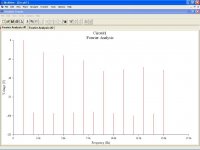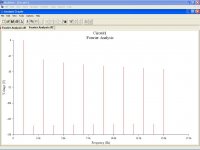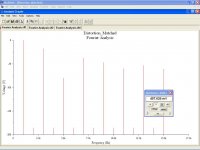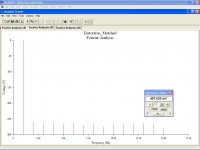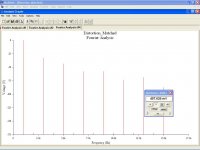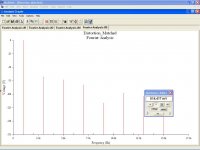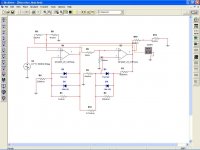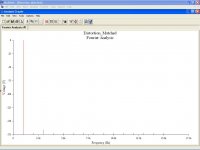Sorry Ed, this seems to be totally pointless. Who would design such stupid circuits???????
Pavel,
The point is that when you cascade two amplifiers the order in which you do it affects the final distortion products. The math used by some others assumes that it does not.
The next issue is if you use local feedback on two amplifiers to get the same gain as if they were cascaded with global feedback is the final distortion the same?
The point is that when designing any amplifier system each gain stage or source of distortion can be optimized for minimum or at least preferred distortion products. This issue seems to be ignored by the global vs local feedback proponents.
ES
I'm not sure what the point of that example is. Of course the order matters, because the signal levels matter. The two amps you show both have significant distortion, and different gain. Where have you seen people using maths which implies the opposite?
BTW I assume you weren't intending that the two amps would have complementary distortion which might cancel out when cascaded? That trick can be done, at least approximately, but not with that circuit.
BTW I assume you weren't intending that the two amps would have complementary distortion which might cancel out when cascaded? That trick can be done, at least approximately, but not with that circuit.
I'm not sure what the point of that example is. Of course the order matters, because the signal levels matter. The two amps you show both have significant distortion, and different gain. Where have you seen people using maths which implies the opposite?
BTW I assume you weren't intending that the two amps would have complementary distortion which might cancel out when cascaded? That trick can be done, at least approximately, but not with that circuit.
Gee, most of the feedback math I have seen assumes that distortion is simple and linear, are you aware of any that does not?
No cancellation intended, I wanted them to have different distortion profiles to show how the interactions create different harmonic structures.
Pavel, This is a tutorial, so the examples need to be very clear. I do not want this to become a "what if you did this with..." When I do the actual hardware I will publish equivalent silly amps, although while set up I just might look at real circuits. ES PS I just got in for repair a one year old mixing console, guess what the op amps are!?
Jan,
FYI
Schematic of high distortion cascaded amplifiers and the results. First is the schematic, second is output from the second amp as shown and third is with the amps positions swapped.
ES
Yes. BTW, no need to convince ME, I already agreed with your view that it makes sense to put the highest gain/ lowest distortion stage first.
jan
Pavel,
The point is that when you cascade two amplifiers the order in which you do it affects the final distortion products. The math used by some others assumes that it does not.
The next issue is if you use local feedback on two amplifiers to get the same gain as if they were cascaded with global feedback is the final distortion the same?
The point is that when designing any amplifier system each gain stage or source of distortion can be optimized for minimum or at least preferred distortion products. This issue seems to be ignored by the global vs local feedback proponents.
ES
I have seen a paper that discussed these issues exactly but for the life of me cannot remember when or where...
jan
Gee, most of the feedback math I have seen assumes that distortion is simple and linear, are you aware of any that does not?
No cancellation intended, I wanted them to have different distortion profiles to show how the interactions create different harmonic structures.
Pavel, This is a tutorial, so the examples need to be very clear. I do not want this to become a "what if you did this with..." When I do the actual hardware I will publish equivalent silly amps, although while set up I just might look at real circuits. ES PS I just got in for repair a one year old mixing console, guess what the op amps are!?
Ed, to be honest, your first example is not totally fair because your distortion factor depends on level with those non-linear diodes. Changing the order does change relative levels and thus changes distortion *factors*. So it is not the same as comparing the order of two circuits with different but constant distortion factors.
jan
Last edited:
Have you seen the wrong maths, or misinterpreted the right maths? Nonlinear distortion depends on signal level - that is clearly shown in the maths. For lowish levels of distortion just use the normal feedback equation, but remember that A (the open loop gain) is a function of signal level. You will have a rational polynomial, which you can then transform into an infinite series by moving the bottom one to the top (using 1/(1-x)=1+x+x^2+x^3+...). I thought you were already doing this?
Sorry to be blunt, but are you trying to solve a non-problem?
Sorry to be blunt, but are you trying to solve a non-problem?
Sorry, for simon7000. I'm not sure what problem he is trying to solve. It seems obvious to me that order of cascaded amplifiers matters, so I am surprised that anyone might think otherwise.
However, if two amplifiers have unity gain then the order does not matter as the transfer function will be simply the product of the two individual functions. There is a small caveat: low levels of odd-order distortion otherwise there will be expansion or compression so the effective gain will vary.
However, if two amplifiers have unity gain then the order does not matter as the transfer function will be simply the product of the two individual functions. There is a small caveat: low levels of odd-order distortion otherwise there will be expansion or compression so the effective gain will vary.
We are not in general disagreement. If you go through almost any of the threads here you will find adherents of no feedback, lots of global feedback, local feedback etc. I really don't want to cite any of the oversimplified papers because life is too short to explain to the authors where they went wrong because if they didn't get the math when they wrote it they probably still don't understand it. My quick google found many simplified explanations. There are many who seem to think the stage gain does not affect how the distortion products behave as both output and artifacts see the same gain. So while it seems reasonable to use low distortion stages first the other approach is to use low distortion circuits at the highest gains.
My observation is that single gain stages inside a feedback loop should work best. Yet some modeling shows otherwise!
The issue we probably are not in agreement is what is linear vs non-linear and how accurate the math is compared to reality. Obviously a reasonable step is to use all my distortion modules with the same gain and same input.
The base issue is that ninth or eleventh harmonic distortion is much worse that third or most even order versions. So it is wise to identify which combinations of gain stages and types will minimize this problem. Classic math as you mention looks at the products of the stages and you recognize the small errors due to the other non-linear components will cause what should be a small deviation from that. Experiments indicate there may be more issues, but they are still in the preliminary stage.
A good design balances all of the issues, so understanding the actual trade offs using non perfect components is only a starting point.
My observation is that single gain stages inside a feedback loop should work best. Yet some modeling shows otherwise!
The issue we probably are not in agreement is what is linear vs non-linear and how accurate the math is compared to reality. Obviously a reasonable step is to use all my distortion modules with the same gain and same input.
The base issue is that ninth or eleventh harmonic distortion is much worse that third or most even order versions. So it is wise to identify which combinations of gain stages and types will minimize this problem. Classic math as you mention looks at the products of the stages and you recognize the small errors due to the other non-linear components will cause what should be a small deviation from that. Experiments indicate there may be more issues, but they are still in the preliminary stage.
A good design balances all of the issues, so understanding the actual trade offs using non perfect components is only a starting point.
Yes, people believe all sorts of things. They sometimes try to propagate their confusion. I have not seen any which claim that distortion is independent of level - maybe if I saw one of those I would simply ignore anything he said anyway!
'Using low distortion stages first' is a statement which might not have an unambiguous meaning. Given two stages with the same gain, the one with the highest non-linear coefficients in the polynomial expansion should probably be put first as here it will have the smallest signal. In addition, for polynomial transfer functions, global NFB is probably better than local NFB because the early stage has much less signal and this is likely to be more beneficial than local feedback. However, this assumes flat frequency response so not very realistic!
If an amplifier has a low dominant pole (e.g. typical SS power amp) then it also may be best to put the distortion before it if possible - then the pole will attenuate harmonics, which will partly compensate for the loss of NFB at higher frequencies. Unfortunately the typical SS amp has crossover distortion coming after the dominant pole.
I think your quest for clarity may be difficult, because you must ensure you are comparing like with like. The maths is fine for Class A, as that will have a polynomial response. Class B is more messy! A good principle to follow is that you have to understand the simple case with ideal components before you try to tackle the real world. Many people seem not to realise this.
'Using low distortion stages first' is a statement which might not have an unambiguous meaning. Given two stages with the same gain, the one with the highest non-linear coefficients in the polynomial expansion should probably be put first as here it will have the smallest signal. In addition, for polynomial transfer functions, global NFB is probably better than local NFB because the early stage has much less signal and this is likely to be more beneficial than local feedback. However, this assumes flat frequency response so not very realistic!
If an amplifier has a low dominant pole (e.g. typical SS power amp) then it also may be best to put the distortion before it if possible - then the pole will attenuate harmonics, which will partly compensate for the loss of NFB at higher frequencies. Unfortunately the typical SS amp has crossover distortion coming after the dominant pole.
I think your quest for clarity may be difficult, because you must ensure you are comparing like with like. The maths is fine for Class A, as that will have a polynomial response. Class B is more messy! A good principle to follow is that you have to understand the simple case with ideal components before you try to tackle the real world. Many people seem not to realise this.
I have cleaned things up a bit. I set the two stages to have a gain of 5. I placed a 5/1 divider on the input and between the stages. I then used stage 1 feeding stage two. I then reversed it and had stage two feed stage one. So both ways the input and output voltage of each stage was the same. I then had stage one drive stage two without the divider but with a global feedback resistor to keep the final output the same.
The results are quite a surprise! Feedback did lower the overall distortion as expected, but less feedback with stage two feeding stage one was clearly the best result!
The results are quite a surprise! Feedback did lower the overall distortion as expected, but less feedback with stage two feeding stage one was clearly the best result!
Attachments
Given two stages with the same gain, the one with the highest non-linear coefficients in the polynomial expansion should probably be put first as here it will have the smallest signal.
You'd probably want to weight them?
And here is the big surprise. This is amplifier two feeding amplifier one with out the 5 to 1 input pad but with feedback to get the same output.
Yes this is an extreme example, but more global feedback here is worse than less local!
Yes this is an extreme example, but more global feedback here is worse than less local!
Attachments
Last edited:
Increasing the gain to 5 might have made the two amps more closely complementary to each other (depends on exactly how you did it), so with the same signal level there will be significant distortion cancellation. This cancellation disappears in the feedback case, as the two amps have very different signal levels. So your results are not surprising. No general conclusions can be drawn from this highly artificial situation. You are not comparing like with like.simon7000 said:The results are quite a surprise! Feedback did lower the overall distortion as expected, but less feedback with stage two feeding stage one was clearly the best result!
You mean multiply in the preceding gain? Yes, this makes comparison easier.SY said:You'd probably want to weight them?
Last edited:
Actually I made them more similar to each other and less complimentary. I am pretty sure you know which stage has less distortion now! The issue that popped up seems to be gain hogging in a global feedback situation. One stage gets run until it is very non-linear and the other gets less than it's share of gain.
Also attached is a better gain sharing version of the Two feeding One with feedback. Now Global feedback is an improvement.
BTY thanks for your enforcing the rigor of the experiment.
ES
Also attached is a better gain sharing version of the Two feeding One with feedback. Now Global feedback is an improvement.
BTY thanks for your enforcing the rigor of the experiment.
ES
Attachments
Last edited:
I think this is important. The only thing global fb does is divide the open loop distortion by the feedback factor. So, you need to look at the ol distortion in each case to decide which you like better in the open loop situation, having in the back of your mind that you can use nfb to lower the cl distortion. Not sure I make myself clear but saying that in some situations nfb gives higher distortion than in some other situations with some local fb involved (or vice versa) doesn't give you a general rule that you can apply.
jan didden
jan didden
- Status
- Not open for further replies.
- Home
- Member Areas
- The Lounge
- John Curl's Blowtorch preamplifier part II
